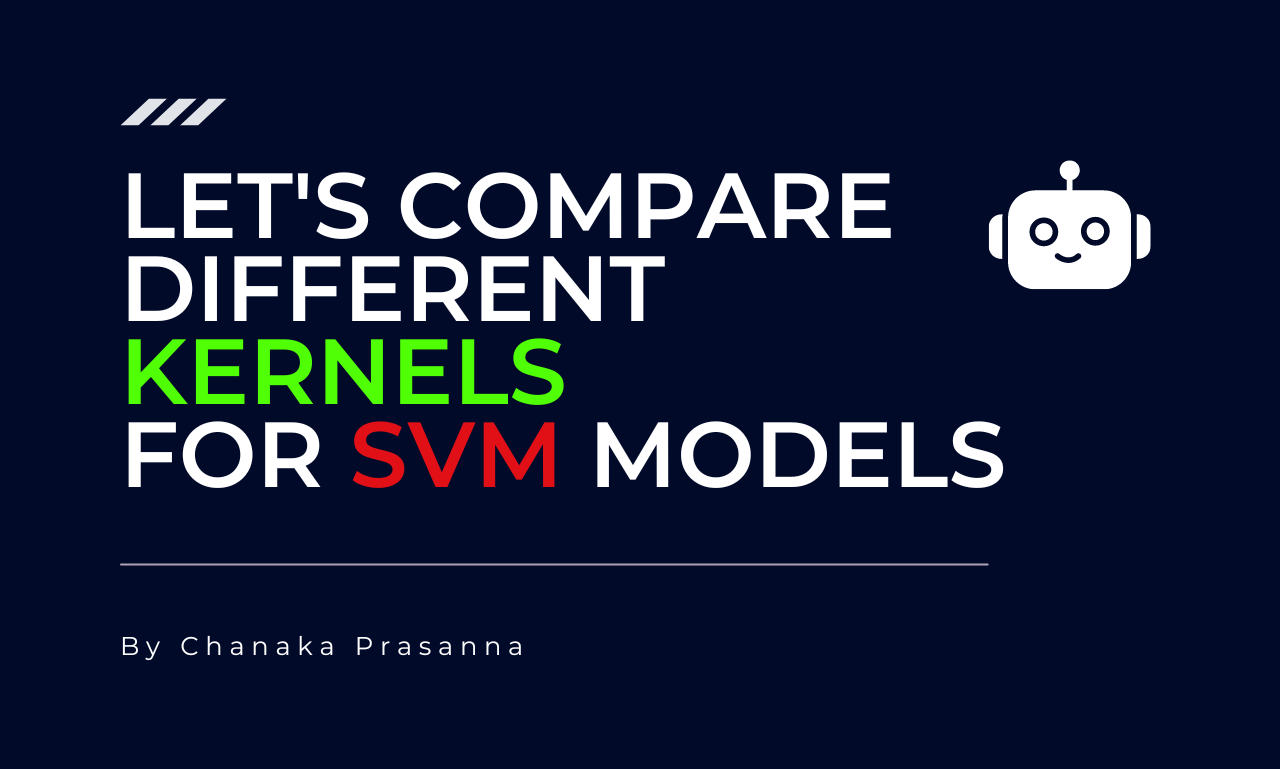Confused About SVM Models? Here's How to Choose the Best One for Your Data!

What are Support Vector Machines (SVMs)?
Support Vector Machines (SVMs) are powerful tools used in supervised machine learning for tasks like classification, regression, and finding outliers (data points that don't fit the general pattern). Think of them as a way to draw a line (or a curve) that best separates different types of data in a dataset.
What will we cover here?
- Advantages of SVMs
- Disadvantages of SVMs
- Data Compatibility
- Classification using SVMs
- SVC
- NuSVC
- LinearSVC
- Regression using SVMs
- SVR
- NuSVR
- LinearSVR
Advantages of SVMs
- Handles High-Dimensional Data Well - SVMs are effective even when you have many features (dimensions) in your data. For example, imagine you have a dataset with hundreds of features. SVMs can still perform well.
- Good for Small Sample Sizes - Even if you have fewer data samples than features, SVMs can still be useful. This is because they use only a subset of data points (called support vectors) to make decisions, which makes them efficient.
Support Vectors-These are the data points that lie closest to the decision boundary or margin. They are essential because they determine the position and orientation of the hyperplane that separates different classes - Memory Efficient - SVMs only need to store a small number of training points, which helps in saving memory.
- Versatile Kernels - You can choose different types of functions (called kernels) to decide how to separate your data. This flexibility helps in dealing with various types of data. Scikit-learn provides common kernels, but you can also create your own if needed.
kernel- A mathematical function in SVMs that transforms data to make it easier to group and classify.
Disadvantages of SVMs
- Risk of Overfitting with Too Many Features - If your data has a lot of features compared to the number of samples, SVMs might overfit (perform well on training data but poorly on new data). It's important to carefully choose the kernel function and regularization terms to avoid this issue.
- No Direct Probability Estimates - SVMs don't directly give probability estimates for predictions. To get probabilities, you need to use a time-consuming method like five-fold cross-validation.
Data Compatibility
SVMs in Scikit-learn can work with both dense data (like arrays) and sparse data (like matrices). For best results, ensure that if you're using sparse data, the model has been trained on similar data types. Dense data (arrays) or sparse matrices in a specific format (like scipy.sparse.csr_matrix) usually work best.
Classification using SVMs
Classification is a type of machine learning task where the goal is to categorize input data into predefined classes or categories. For example, given a set of features or attributes of an object, classification algorithms can predict what category the object belongs to.
Imagine you have a basket of fruits, and you want to sort them into two categories called apples and oranges. You can use a classification model to help with this task. Here's a simple example:
- Input Features - Color, Size
- Classes - Apple, Orange
If you have a fruit that is red and small, the classification model might predict that it's an apple (Assuming there are no other red fruits). If the fruit is orange and medium-sized, it might predict that it's an orange.
In essence, classification helps you automatically sort or label items based on their features!
For the classification tasks, we can use three SVM estimators called SVC, NuSVC and LinearSVC . Let's understand one by one.
SVC
SVC stands for Support Vector Classification.
- The problem - When you have a lot of data points (like tens of thousands), SVC takes a really long time to learn. This is because its learning process gets slower and slower as the amount of data grows. May be impractical beyond tens of thousands of samples.
- Why it's slow - The technical reason is that the time it takes to learn grows at a rate that's similar to multiplying a number by itself (quadratic). So, doubling the data doesn't just double the learning time, it quadruples it.
- Solutions
- Smaller datasets - If you have a smaller amount of data, SVC can work well.
- Faster learners - For large datasets, use methods like LinearSVC or SGDClassifier. These learn much quicker.
- Data reduction - You can also try to shrink your dataset without losing important information. Techniques like Nystroem transformer can help with this.
SVC is great for smaller tasks, but when dealing with large groups of data, it's better to use other tools that can learn faster
NuSVC
NuSVC is like SVC, but with a twist. Both are methods for sorting data into different groups.
- The problem - SVC can sometimes be picky about which data points it uses to make its decisions.
- NuSVC's solution - NuSVC gives you more control over this. It has a special setting called
nuthat lets you decide how many data points should be involved in making the decisions. - How it works - Similar to SVC, it's also slow for large datasets and uses the same tools (
libsvm) to do its calculations.
Let's understand about nu
In NuSVC (Nu Support Vector Classification), nu is a parameter that controls the trade-off between the margin size and the classification error. It’s a bit different from the regular SVM because it allows for some flexibility in the number of support vectors and the amount of misclassification. It allows for some flexibility in the number of support vectors and the amount of misclassification.
1. Lower Bound for Support Vectors
- The parameter
nudetermines the proportion of training samples that can be support vectors. The lower bound is the minimum number of support vectors you can expect. - With
nu = 0.5, at least 50% of your training samples will be support vectors. This is becausenucontrols the fraction of support vectors and margin errors, andnu = 0.5means that half of your training data could end up being support vectors.
2. Upper Bound for Misclassified Samples
-
nualso sets an upper bound on the fraction of training samples that are allowed to be misclassified or fall on the wrong side of the hyperplane. nu = 0.5also means that at most 50% of your training samples can be on the wrong side of the hyperplane (i.e., misclassified or margin errors). This sets a maximum limit on the fraction of samples that can be misclassified.
More Support Vectors
A higher nu value does indeed result in more support vectors. Since nu sets a lower bound on the fraction of support vectors, increasing nu means that a larger portion of the training samples must be support vectors.
More Margin Errors
A higher nu value also allows for a higher proportion of training samples to be margin errors (either misclassified or within the margin). This is because nu sets an upper bound on these errors, meaning that as nu increases, the model tolerates more margin errors
NuSVC is like SVC, but you have a say in how many data points the model looks at when making choices. It's still a bit slow for large datasets.
LinearSVC
LinearSVC stands for Linear Support Vector Classification.
Similar to SVC with parameterkernel=’linear’, but implemented in terms ofliblinearrather thanlibsvm, so it has more flexibility in the choice of penalties and loss functions and should scale better to large numbers of samples.
~ From the documentation

The problem - When you have a large number of data points, traditional SVC can be very slow because of the complexity of its calculations. LinearSVC aims to address this issue by providing a faster alternative.
Why it’s faster - The technical reason for its speed is that LinearSVC uses a simpler linear decision boundary, unlike SVC, which can handle more complex boundaries. The time it takes to learn grows at a rate that’s similar to a linear function, meaning doubling the data doesn’t significantly increase the learning time, making it much faster for large datasets.
Large datasets - LinearSVC is ideal when you have a large dataset and need faster processing. It handles the data more efficiently by assuming a linear separation.
Efficient learning - For datasets where a linear decision boundary is sufficient, LinearSVC can provide quick results without the computational expense of SVC.
Complex data - If your data requires more complex decision boundaries, you might still need SVC or NuSVC, but for many practical applications, LinearSVC is a solid choice for its speed.
LinearSVC uses squared_hinge loss
Some terms that you may encounter while you are reading the above-linked resource.
- Penalty - In the context of machine learning and optimization, a "penalty" refers to a measure of cost or error associated with making incorrect predictions or using certain model parameters. It helps guide the model training process by encouraging desired behaviors and discouraging undesirable ones.
- Penalizes a Prediction - This means the model imposes a cost for making certain types of errors or predictions. By incorporating these penalties, the model adjusts its parameters to reduce errors and improve overall performance, which is crucial for effective learning and optimization.
Regression using SVMs
Support Vector Machines are not just for classification tasks. They can also be extended to solve regression problems. This method is known as Support Vector Regression (SVR). Like Support Vector Classification, SVR aims to find a function that deviates from the actual observed values by a small amount (within a threshold), while maximizing the margin.
How it Works
In SVR, the model relies only on a subset of the training data, called support vectors, similar to Support Vector Classification. The main difference is that in regression, the goal is to minimize the error between predicted values and actual values while keeping the model simple.
- Epsilon-Insensitive Loss Function - SVR introduces the concept of an epsilon margin of tolerance, where predictions within a certain distance (epsilon) from the true value are not penalized.
Implementations of Support Vector Regression
There are three primary implementations of Support Vector Regression in Scikit-Learn
- SVR
- NuSVR
- LinearSVR
Let's explore each one in detail
SVR
SVR stands for Support Vector Regression. It is the most general implementation and allows for a variety of kernel functions (linear, polynomial, RBF, etc.), making it suitable for both linear and non-linear regression problems.
- Kernel Flexibility - SVR can use various kernel functions to capture complex relationships in the data.
- General Use - Ideal for both small and large datasets, though it can be slower on very large datasets due to its flexibility.
Challenges
- Slower Learning - Like SVC, the time complexity can grow significantly with the number of data points, making SVR slower for large datasets.
- Parameter Tuning - Careful tuning of hyperparameters like
C,epsilon, and the kernel is necessary to get good performance.
When to Use
- Non-linear Relationships - SVR is best suited for datasets where the relationship between the features and target is non-linear.
NuSVR
NuSVR is similar to SVR but introduces a parameter nu that controls the number of support vectors and the margin of error.
- Control Over Support Vectors -
nuprovides more flexibility in determining how many support vectors are used. - Epsilon-Insensitive Loss - Like SVR, NuSVR uses an epsilon-insensitive loss function but with an additional control over support vector count.
When to Use
- When More Control is Needed - NuSVR is beneficial when you want greater control over the number of support vectors and the balance between margin size and errors.
LinearSVR
LinearSVR stands for Linear Support Vector Regression. It is a faster alternative to SVR that assumes a linear relationship between features and the target variable.
- Speed - LinearSVR is much faster than SVR, especially on large datasets, due to its simpler linear kernel.
- Efficient for Large Data - It scales well with large datasets, making it ideal when a linear relationship suffices.
Challenges
- Only Linear Kernels - Unlike SVR and NuSVR, LinearSVR only works with linear kernels, so it may not capture complex non-linear relationships.
- Intercept Regularization - LinearSVR regularizes the intercept term by default, but this can be fine-tuned using the
intercept_scalingparameter.
When to Use
- Large, High-Dimensional Data - When you need to quickly fit a model on large datasets and a linear model is sufficient.
In conclusion, Support Vector Machines (SVMs) are powerful tools in machine learning, offering flexibility in handling both classification and regression tasks. They excel in high-dimensional data and small sample sizes, using only essential data points called support vectors for decision-making. With different versions like SVC, NuSVC, and LinearSVC for classification, and SVR, NuSVR, and LinearSVR for regression, SVMs provide tailored solutions depending on the dataset size and complexity. However, they do have challenges, such as potential overfitting and slower performance with large datasets. Overall, SVMs are versatile and effective, but choosing the right variant and tuning parameters is key for optimal results.
For additional read

If you read up to this point, that means you got something from here. So encourage me to write more like this by subscribing. And don't forget to follow me on LinkedIn as well. Also, help your friends by sharing this.



